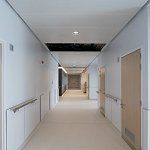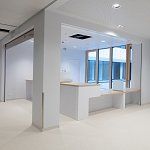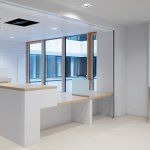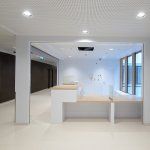The New Jules Bordet Institute, a building designed to welcome leading edge medicine and technologies now and into the future
12/03/2021
The New Jules Bordet Institute, a building designed to welcome leading edge medicine and technologies now and into the future
Technology for diagnosing and treating cancer is developing at a rapid rate, permitting more individualised, precise and effective cancer treatment for each patient. The new Jules Bordet Institute building is designed to welcome these leading edge technologies now and into the future. The fully radiation-protected lower ground floor (-1) is dedicated to technical medical procedures. Here you will find the Radiotherapy Department that has recently acquired an MRI-Linac thanks to the support of the ”Friends of the Bordet Institute”. This totally innovative technology and a premiere in Belgium combines high precision magnetic resonance imagery (1.5 Telsa MRI) and adaptive tumour irradiation using a linear accelerator (LINAC). This makes it possible to modify the field of irradiation during treatment according to the reduction in tumour volume and thereby reduce any side effects to a minimum. This latest technology is in addition to the three other new linear accelerators and one upgraded accelerator, the Gamma Knife (at the Erasmus Hospital) and the Mobertron (system of radiotherapy applied during surgery), as well as a brachytherapy device. Located in close proximity to radiotherapy, the Radiology Department’s diagnosis and treatment activities also benefit from high technology with machines of the latest generation (CT scanners, MRIs, mammograms, ultrasound scanners) providing all the imagery needed to diagnose and treat cancerous lesions. This floor dedicated to technical medical procedures is also home to the Nuclear Medicine Department (equipped with two SPECT-CTs and two PET-CTs, one reserved exclusively for medical research). The department includes a radiopharmacy (with GMP quality standards) to permit the production of radiotracers for use in diagnosis (molecular imagery) and treatment (markers marked with radionuclides emitting ionising and oncolytic particles). The concentration of all these departments on a single floor, in close proximity the one to the other, aims to ensure the perfect integration of these different methods of diagnosis and treatment through close inter-departmental cooperation and the ease of patent transfer from one machine to another as part of an increasingly personalised medicine.
The Jules Bordet Institute, an integrated reference centre in the fight against cancer, is ready to welcome you from November 2021 on the site of the ULB in Anderlecht.
Photos by Marc Detiffe
© Marc Detiffe (detiffe.com)
More info : A new building for the Institut Jules Bordet



